C. Sidewalks and Walkways
1. Typical Issues for Individuals Who Use Wheelchairs, Scooters, or other Mobility Devices
An accessible route connects accessible passenger drop-off areas, accessible parking spaces, and other accessible elements, like a route from a bus stop, to an accessible building entrance. The accessible route is essential for people who have difficulty walking or who use wheelchairs or other mobility aids to get to the accessible entrance of the shelter. The accessible route must be at least 36 inches wide (it may narrow briefly to 32 inches wide where utility poles, signs, etc. are located along the accessible route). Abrupt level changes, steps, or steep running or cross slopes cannot be part of an accessible route. Where ramps are used, they cannot be steeper than 1:12. Ramps with a vertical rise of more than 6 inches must have handrails on both sides. Ramps must also have edge protection to stop wheelchairs from falling off the sides, and level landings at the top and bottom of each segment and where the ramp changes direction.
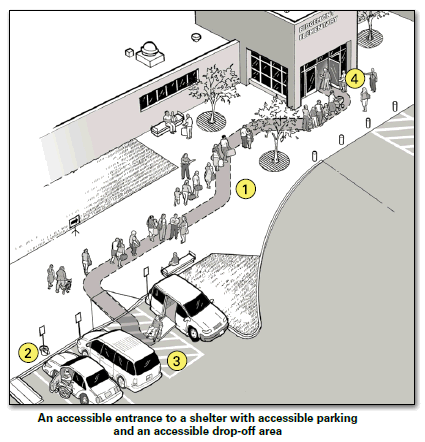
Notes:
1. Accessible route
2. Accessible drop-off area
3. Accessible parking with van-accessible parking space
4. Accessible entrance to shelter
C1-a. Is an accessible route provided from accessible parking spaces to the accessible entrance of the shelter? [ADA Standards § 4.1.2(1), 4.3]
Yes
No
C1-b. Is an accessible route provided from public sidewalks and public transportation stops on the shelter site (if provided) to the accessible entrance for the shelter? [ADA Standards § 4.1.2(1)]
Yes
No
Note: The accessible route is at least 36 inches wide and may be a portion of a sidewalk.
C1-c. Is the accessible route at least 36 inches wide? [ADA Standards § 4.3.3]
Yes
No
If No, does the accessible route narrow to 32 inches for no more than 2 feet?
C1-d. Is the accessible route free of steps and abrupt level changes higher than 1/2 inch? [ADA Standards § 4.3.8]
Yes
No
Note: Level changes between 1/4 inch and 1/2 inch should be beveled (sloped) at 1:2 maximum.
C1-e. Where an accessible route crosses a curb, is a curb ramp provided? [ADA Standards § 4.3.8]
Yes
No
e-i. Is the curb ramp surface at least 36 inches wide, excluding flared sides? [ADA Standards § 4.7.3]
Yes
No
e-ii. Is the running slope (up or down the ramp) no more than 1:12? [ADA Standards § 4.7.2]
Yes
No
Note: 1:12 is one inch of vertical height for 12 inches of horizontal distance.
C1-f. If the slope of part of the accessible route is more than 1:20, does it meet the following requirements for an accessible ramp?
Yes
No
f-i. Is the running slope no greater than 1:12? [ADA Standards § 4.8.2]
Yes
No
Note: For existing ramps, the slope may be 1:10 for a 6-inch rise and 1:8 for a 3-inch rise in special circumstances (see ADA Standards § 4.1.6(3)).
f-ii. Are handrails installed on both sides of each ramp segment? [ADA Standards § 4.8.5]
Yes
No
f-iii. Is the ramp width, measured between the handrails, at least 36 inches? [ADA Standards § 4.8.3]
Yes
No
f-iv. Does the ramp have a level landing at the top and bottom of each ramp section that is at least 60 inches long? [ADA Standards § 4.8.4]
Yes
No
Note: The level landing may be part of the sidewalk or walking surface.
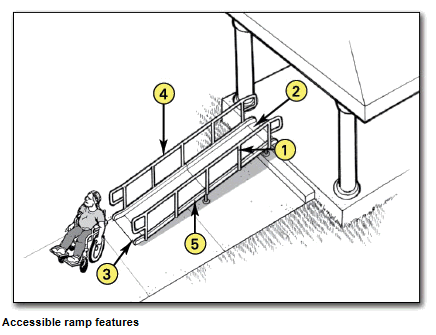
Notes:
1. At least 36 inches between handrails
2. Top landing part of walk
3. Bottom landing part of walk
4. Handrail height 34 to 38 inches
5. Edge protection.
f-v. If a ramp is more than 30 feet long, is a level landing at least 60 inches long provided at every 30 feet of horizontal length? [ADA Standards § 4.8.4]
Yes
No
Note: if the running slope is less than 1:16 but more than 1:20, each ramp segment may be up to 40 feet long followed by a level landing].
f-vi. Is there a level landing, at least 60 inches x 60 inches, when a ramp changes direction? [ADA Standards § 4.8.4]
Yes
No
f-vii. Are the handrails mounted 34 to 38 inches above the ramp surface? [ADA Standards § 4.8.5]
Yes
No
f-viii. If the ramp or landing has a vertical drop-off on either side, is edge protection provided? [ADA Standards § 4.8.7]
Yes
No
Temporary Solutions For Emergency Sheltering - Ramps
Problem: The sidewalk connecting parking to the shelter entrance is too steep to be accessible.
Suggestion: Check to see if there is another accessible route to the accessible entrance. Sometimes there is a less direct route that is accessible. During an evacuation it will be helpful to put up signs or to have volunteers stationed at the accessible parking spaces to direct people along this less direct, but nonetheless accessible, route.
Problem: The accessible route crosses a curb but no curb ramp is provided.
Suggestion: Install a portable ramp with a slope no steeper than 1:12 with edge protection. Store the portable ramp on site so it can be easily accessed in an emergency.
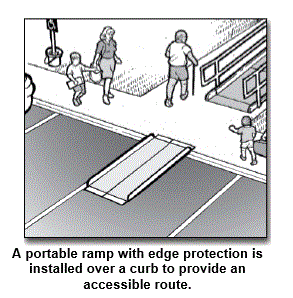
Problem: There are two steps where the sidewalk connects to the accessible entrance.
Suggestion: Install a portable ramp with a slope no steeper than 1:12 with edge protection and handrails on both sides of the ramp. Store the portable ramp and components on site so everything can be easily accessed in an emergency.
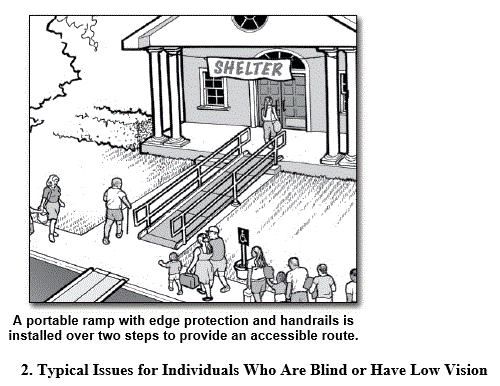
2. Typical Issues for Individuals Who Are Blind or Have Low Vision
Objects that are wall mounted, that project into a pedestrian route from the side, or that are overhead can be hazards to people who are blind or who have low vision. These objects must be positioned so people will either detect the objects before they run into them or safely pass under them. Examples may include handrail extensions on stairs and ramps, post- or wall-mounted signs, drinking fountains, and low hanging tree limbs. Pedestrian routes open to people during the time that the facility is being used as an emergency shelter, such as sidewalks, courtyards, and plazas, must be free of overhanging objects that are less than 80 inches above the route. Objects more than 27 inches and less than 80 inches above the route and that protrude from the side more than 4 inches are also a hazard. Since people can walk on any sidewalk, not just the accessible routes, all exterior pedestrian routes serving or leading to the shelter areas must be checked. The following questions apply to sidewalks and walkways leading to the emergency shelter.
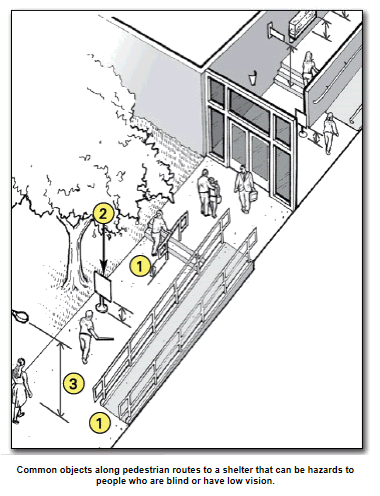
Notes:
1. The bottom of the handrail extensions turn down to 27 inches or less above the route so a person who is blind or has low vision can detect the hazard before running into it.
2. Signs or other objects in the pedestrian route can be a hazard if the bottom is more than 27 inches but less than 80 inches above the route.
3. Objects that overhang the pedestrian route must be at least 80 inches above the route.
C2‒1. Are all sidewalks and walkways to the shelter free of any objects (e.g., wall-mounted boxes, signs, handrail extensions) with bottom edges that are between 27 inches and 80 inches above the walkway and that extend more than 4 inches into the sidewalk or walkway? [ADA Standards §§ 4.4, 4.2.1(3) [sic], 4.1.3(2)]
Yes
No
If No, can the object be lowered, removed, or modified or can the route be moved so that the object can be avoided?
C2‒2. Are the undersides of exterior stairs enclosed or protected with a cane-detectable barrier so that people who are blind or have low vision will not hit their heads on the underside? [ADA Standards § 4.4.2]
Yes
No
If No, can a barrier or enclosure be added below the stair or can the route be relocated away from the stair?
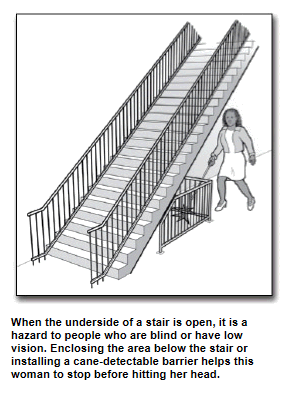
C2‒3. Are all objects that hang over the pedestrian routes at least 80 inches above the route? [ADA Standards § 4.4.2]
Yes
No
If No, can the objects be removed or relocated, or can a cane-detectable object be added below that is at no higher than 27 inches?
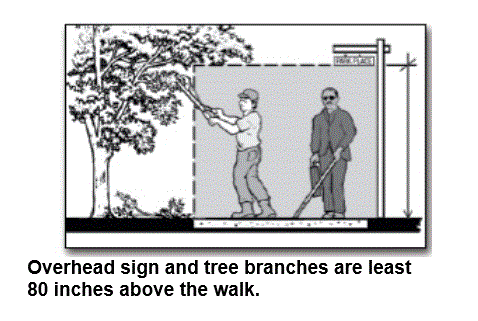
Temporary Solutions For Emergency Sheltering - Protruding Object Hazards
Problem: Objects protrude too far from the side into the route causing a hazard for people who are blind or who have low vision.
Suggestion: When people who are blind or who have low vision use a cane to detect hazards, objects located at 27 inches or lower are detectable. When an object is located higher than 27 inches above the ground it is a hazard if the object protrudes more than 4 inches into the circulation path. To make a protruding object cane-detectable:
-
Place an object below, or on either side of, the protruding object that is not higher than 27 inches above the ground. If the protruding object can be moved, lower the object so that its bottom is not more than 27 inches above the ground. Prune or alter the protruding object so it does not protrude above the route.

User Comments/Questions
Add Comment/Question